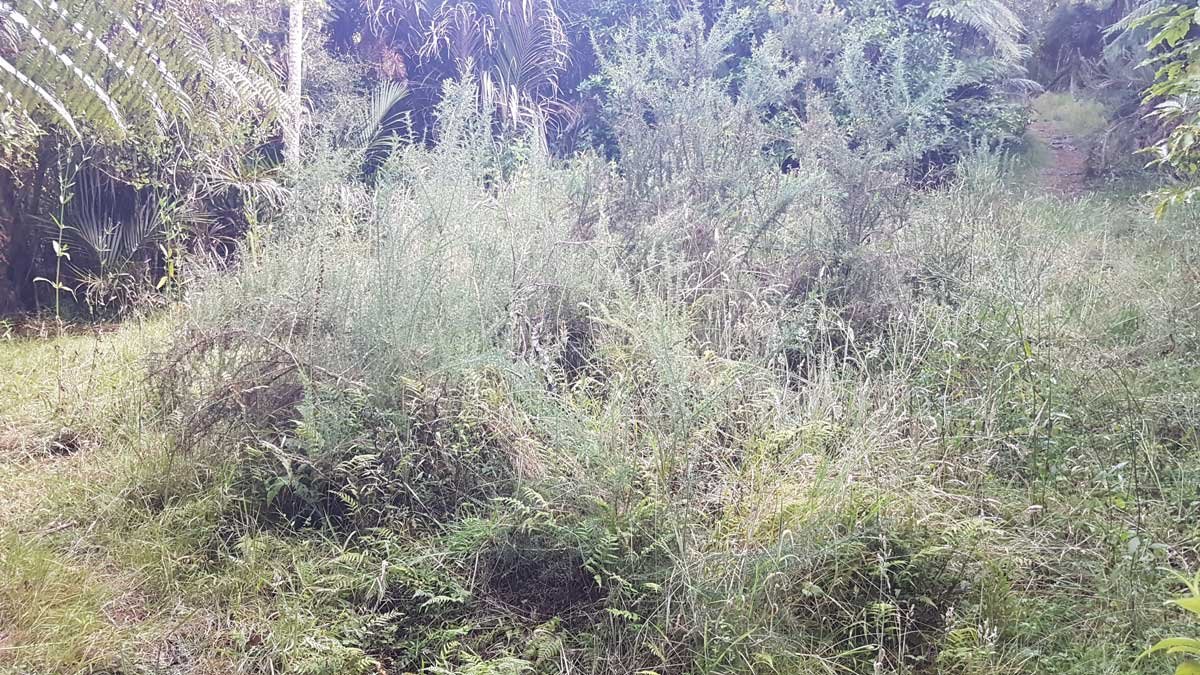Our property comes in two blocks. The main block is where we live, and has the fenced paddocks for the cows. The other section is a 4.5ha covenanted, old-bush block.
Inside that bush block is a rain-fed pond (shown above). We’ve been getting a lot of rain lately, so the pond is currently deep and inviting. Over lockdown, our dog Roxy really got the hang of swimming, so we’ve been going out there more regularly.
Just before you reach the pond, there is a clearing. When we purchased it, it contained a large Taiwan cherry tree and some grand-daddy gorse.
We took out the cherry tree in our first summer here. We cut it down with a chainsaw and poisoned the stump by painting it with Mesulfuron methyl. It was the first cherry we cut down. We didn’t really know what we were doing, but It did the job: a couple of years later that tree is dead and colonised by fungi.

Before
These photos are from January (and could be better, sorry), but they show the gorse and the kikuyu growing in the clearing.
Important to note, that amongst the invaders are native ferns, white rātā, and clumps of native carex grasses. I didn’t want to go in and just spray it out. It all needed clearing out by hand, painting each stump as we went.
Weed-busting kit
It’s taken me a couple of years to really perfect my weed-busting kit, but I’ve got it down to something that seems to work for us now. It contains 2 buckets, an old peanut butter jar, a paint brush, some gloves, a pruning saw, and a pair of loppers.

The big bucket holds everything – plus a drink bottle. It makes it easy to cart everything to the site.
The smaller bucket holds a peanut butter jar of herbicide, and the paintbrush. I’ve found it’s easiest to keep the jar of herbicide open while working, rather than opening and closing it over and over. Keeping the open container in the small bucket seems quite effective at preventing spills, and has made swiping each plant much faster and less fiddly.
I use the pruning saw on anything thicker than about 15mm. I got sick of fighting with old rusty ones and purchased myself a nice new one this season. Sharp tools are the business. The loppers make quick work of smaller trunks and branches.
Finally, the gloves. I am a HUGE fan of Showa 305 Grip Xtra latex gloves (size L if you’re ever stuck for buying me a gift – I will never have too many pairs). These gloves make me fearless around gorse. I don’t even feel it. They are an amazing and incredible piece of engineering. Specifically when clearing weeds, a good pair of gloves is utterly essential.
After
Yesterday we felt motivated to take the kit into the bush and clear the clearing.
In the end, it took two of us less than 3 hours to remove and poison the gorse and Himalayan honeysuckle. We also cut up a fallen tree fern (turns out, way harder than it looks!) and used the punga logs to line the edge of the clearing.

All the gorse and other plant matter went down a bank – weighed down by the cherry we cut down a couple of years ago. There, it’ll break down and add nutrients to the soil. The bush will overwhelm it in time.
From here, we’ll probably tidy up the grass a little. Maybe find a picnic table and build a ‘stick library’ for the dogs. It’s a nice spot, and I’m happy to share it with my neighbours and their animals. With a little time and maintenance, it’ll be a lovely location for a picnic – though I’m not sure I’m brave enough to camp there!







Great work, that looks awesome, Kat.